Self organisation is not so much a structural model as it is a practice. And while models can simply be adopted, the road to mastering a practice is practice itself: research converges on a number of 10.000 hours to reach excellence in any craft [1] (for example, if you want to become an “excellent” pianist, you need to invest three hours of piano practice per day for at least 10 years). So what makes us think that to master self organization, all we need to do is enthusiastically read Laloux[2] and change our org chart from boxes to circles? No, my friends, we need to train and – depending on our past entanglements – we need to train hard.
In one of the more inspiring break-out sessions during the Great Covid Rewiring, I had the pleasure to meet Trine Demant of “Democracy Fitness”[3]. She and her team have developed a series of short programs to train “Democracy Muscles” – personal skills and abilities that are underused but deemed critical to actively shape and participate in a vibrant democracy. The muscles include “Verbal Self-Confidence”, ”Empathy”, “Mobilisation” and more.
 The sessions are designed to be activating and fun but also challenging – “If it hurts a bit, it is a good sign you are executing the exercises the right way”, the intro manual reads. What’s most baffling: Each training only takes 30 minutes. Hey, what happened to the 10.000 hours? Well, you have to start somewhere – the training is merely the introduction to an underused part of your potential. In the words of democracy fitness: “When you are done, you will always remember that you and others have this muscle”.
The sessions are designed to be activating and fun but also challenging – “If it hurts a bit, it is a good sign you are executing the exercises the right way”, the intro manual reads. What’s most baffling: Each training only takes 30 minutes. Hey, what happened to the 10.000 hours? Well, you have to start somewhere – the training is merely the introduction to an underused part of your potential. In the words of democracy fitness: “When you are done, you will always remember that you and others have this muscle”.
Fascinated with the approach I quickly started to wonder: how does this translate to Self Organisation Development? If we accept that we need to train to successfully relate in new ways of working together, exactly which parts of our abilities should we cultivate? My hunch is, the muscles of self organisation are not that far off from the democracy fitness muscles.
We pondered this question at our last SOCIUS retreat on the Adriatic coast. The following collection of the Seven Muscles of self organisation is a result of these conversations:
- Cultivating Trust
- Showing Up (in Leadership and Followership)
- Practicing Self-Navigation
- Moving Gracefully in Rough Waters
- Relating with Resonance
- Tuning in to the Living System and
- Feeding the Groove
Of course, there can be other versions, in fact there probably will be plenty of refinements and revisions – but it is a good starting point. Let’s examine these muscles a bit more closely, looking at their relevance for self organisation development and exploring ways of strengthening them:
(all images: Julia Hoffmann)
- Cultivating Trust
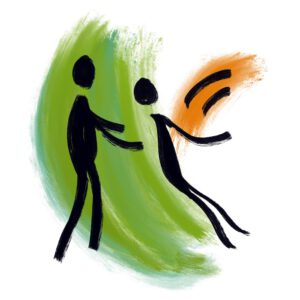 (Trust the Process, trust yourself and others, trust the universe, be patient, stay optimistic)
(Trust the Process, trust yourself and others, trust the universe, be patient, stay optimistic)
One of the most persistent reservations in regard to self organisation practices is the idea that they take too much time. “In calm waters we can afford the luxury of decentralised control, but when the weather gets rough and stakes are high we better revert to something more responsive and efficient”. Let’s unpack this notion a bit: What slows self organisation down is essentially a lack of trust. If I believe my teammates are not competent or will abuse their power and act in ways that benefit their selfish ways rather than our common cause I will try to control them. I will demand reports and final decisions to be taken at plenary meetings, will strive to install approval loops and systems of triple checks and balances – all of which essentially make processes slow and uninspiring. If, on the other hand, I trust that my teammates have the common cause in view and will act with competence (or at least to their best ability), I can go along with minimal viable control and thus enable maximum possible momentum. The zone of what is “safe enough to try” grows.
Can you train this kind of trust? A fundamental ingredient of the trust equation is a phenomenon the psychoanalyst Erik Erikson called “Urvertrauen” – a deep and basic conviction that the world is a good place and I am nurtured by it. According to Erikson’s developmental theory, basic trust is ideally established in the first 1.5 years of a child’s life and builds the foundation for later trust experiences and the ability to have a confident and optimistic outlook on life. A central aspect of this optimism is “People Positivity”[4] – it refers to the conviction that humans are competent, able and – if not primed otherwise – willing to contribute to the common good – a notion McGregor coined as “Theory Y”.
Strengthening our ability to trust can start with the question: “When and how do I feel safe”? – and then more specifically: “When do I feel safe enough to try trusting my colleague in their roles and responsibilities?” The more conscious we are of our basic needs, the better we can understand where others’ actions are rubbing against them and address that in a productive way.
Besides the individual dimension, trust also has a social quality which is shaped by reinforcing feedback loops: Trust breeds trust; it builds on commitments that are honored and promises that are kept. Without such commitments, there is no base to the virtuous cycle of trust. And without a leap of faith there is no jump start to the upward spiral of positive experiences. Both elements can be cultivated.
- Showing Up (in Leadership and Followership)
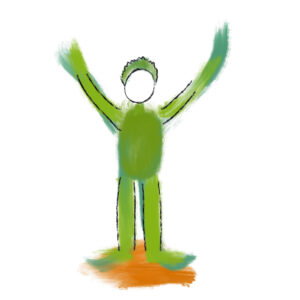 (Dare to Act on an impulse, feel what wants to happen, go ahead, don’t worry about judgement, lead. And: Be ready to follow: recognise and support a good idea, walk along humbly, say Yes!)
(Dare to Act on an impulse, feel what wants to happen, go ahead, don’t worry about judgement, lead. And: Be ready to follow: recognise and support a good idea, walk along humbly, say Yes!)
Leadership is a tricky dance: It requires a balance between staying in tune with your inside – noticing your impulses, trusting your intuition – and sensing and reading the social field around you. When you loose touch with one of the sides, if the two worlds get mixed up or one dominates, your ability to lead is in trouble. While in self organising teams, leadership energy is more dispersed and dynamic than in classic hierarchical organisations, the balancing act between internal and external impulses is equally delicate. Showing up in leadership is about mastering this balance and about the ability to act in it sensibly and with conviction.
Just as leadership, followership in a context of self organisation is rooted in spirited action. It is not about following a personbut about amplifying their impulse. It is not about playing along without objection, but about energising and creatively working with a proposal. As Derek Sievers puts it: “We are told that we all need to be leaders, but that would be really ineffective. The best way to make a movement if you really care, is to courageously follow and show others how to follow”[5].
So how do we train this muscle? First of all, it helps to remember, that we all have foundational leadership and followership experiences. Childsplay is a fluid action dance of leading and playing along. Most children are able to spontaneously come up with an idea and embody it in action or joyfully follow one as it is proposed: “Hey, let’s go there” – “Here is what we can do!”. “Yes, and…”. There are a number of reasons why this innate ability to act on an impulse (or maybe more accurately: to follow ourselves) tends to get buried during adolescence and adulthood: we spend formative years in education systems that favour impulse control over impulsiveness; we spend the better part of our days in more or less regulated workplaces where impulsive action is met with skepticism and reproach; and we inhabit social settings that glorify leadership and at the same time feed the fear of failure and instill a hunch of impostering whenever our action proposals exceed the realm of our formal roles. It is confusing, to say the least. To uncover our innate ability to act on an impulse is to reconnect to playfulness, and to surface and confront those internalised voices and imperatives that stifle our inner child’s impulsive process.
- Practicing Self-Navigation
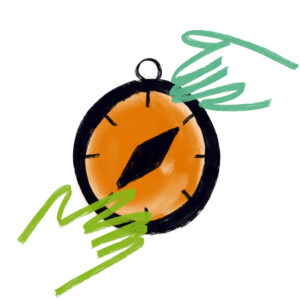 (Be ready to learn and unlearn, cultivate self-awareness, make reflection part of your routines, know your limits and honour them)
(Be ready to learn and unlearn, cultivate self-awareness, make reflection part of your routines, know your limits and honour them)
The road to self organisation calls for a gradual shift from external structures to internal competence and personal development as sources of stability[6]. The muscle of self-navigation is a precondition and product of this process. It builds on the awareness of our inner landscape and draws on the ability to commit and the same time honour our limitations. While hierarchical workplaces are often associated with energetic strain, a frequent experience with self organisation is that finding a healthy level of engagement becomes even harder, as you are co-responsible, not just for yourself but for the whole.
Self-navigation can hardly be learned from a manual. A book may give you ideas and inspirations to try new things or give up an old habit, but the map is not the territory: the real growth happens in reflective action. Committed micro-practices and reflective routines are good containers for that growth. Structural support for building the self-navigation muscle can involve dedicating space and time for these routines and defending them from the greedy waves of daily business.
- Moving Gracefully in Rough Waters
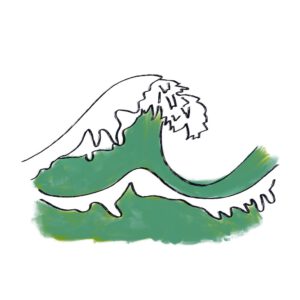 (Dare to disagree, enjoy the productive force of tensions, negotiate firmly, if needed – say No!)
(Dare to disagree, enjoy the productive force of tensions, negotiate firmly, if needed – say No!)
Teams with a strong “people positive” value background often cultivate a dogma of harmony: “I don’t challenge your idea and you don’t challenge mine”. This version of harmony decreases the potential of collective creativity and leads to underperformance in decision making: ideas and contributions are simply added under a broad umbrella rather than being critically screened and selected or merged. Differences of position and interest are smoothed over with a blanket of appreciation: Every point is valid, every perspective is welcome. This kind of harmony is often mistaken for alignment: “If we don’t rub, we must have a common purpose”.
Self organisation practice on the other hand regards tensions as a necessary fuel for development. Holacracy defines them as “gaps between the current reality and a sensed potential”[7]. Processing tensions regularly also is a way of keeping them from escalating into manifest problems and obstructive conflicts.
Moving gracefully in rough waters involves finding a fruitful level of involvement and a sensible dose of addressing tensions. Imagine yourself on a walk finding a large pile of rubble in your way. On a once off trip chances are, you will neither pick up the pile nor climb over it. Depending on your mood, you may stop briefly in wonder or annoyance and then circle around the obstacle to get to your destination. If, on the other hand, this is a route you take on a daily basis, the detour suggests you move that pile in order to have an unobstructed pathway in your future routines . Conflicts and tensions are not much different: The little once off ones and even some isolated dramas we can simply walk around. Why waste energy on something that takes focus away from our cause? In contrast, the tensions that keep getting in our way, we should address, no matter how petty or massive they are.
The way to train moving in rough waters is simple but not easy: practice being around tensions without getting freaked out by them. Initiate tensions in a safe social setting and stay with them without diffusing them. Be critical, be fierce, be impolite, if you need to be. Practice objection, say No. Notice your sensations, your physical and mental reactions. Take notes of your daily work-arounds (and walk arounds) and determine which of these detours you would like to straighten up. And then just do it and notice how life goes on after that.
- Relating with Resonance
 (Listen deeply, cultivate empathy and curiosity, hear with your heart)
(Listen deeply, cultivate empathy and curiosity, hear with your heart)
The relevance of resonance for any social practice is evident. For the practice of self-organization it is crucial: The adaptive quality of self organising systems is focused on fit with their environment which includes their external field but also the dynamics members bring to the table. Most of the interesting stuff in both, the external and the internal spheres, moves below the water line. Resonance on a collective level is about sensing these hidden dynamics.
On a relationship level resonance is related to empathising. Empathy defines the ability to be in tune with another person and to experience their emotional situation. Perspective taking is a good way to cultivate empathy – stepping into someone’s shoes, sharing and feedback. Another route is the practice of deep listening. Some fine recipes for deep listening come from the dialogic practice and from the field of nonviolent communication.
- Tuning in to the Living System
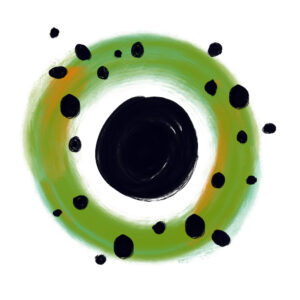 (Recognize patterns and observe dynamics, distrust simplifications, keep the bigger picture in view, see how small things feed purpose, be attentive to emerging orders)
(Recognize patterns and observe dynamics, distrust simplifications, keep the bigger picture in view, see how small things feed purpose, be attentive to emerging orders)
Complexity Consciousness is one of the meta-skills of our time. It refers to the acknowledgement of the interdependent dynamic quality of social processes. It also involves the ability to roll with those dynamics, which requires flexibility, patience and ambiguity tolerance. The special relevance of this muscle for moving in self-organising systems has to do with their specific mix of formal and informal settings.
Follow me into an analogy for a moment: When driving a car, you are managing a complicated system that is built on a bunch of first order mechanics and a few self-regulating feedback loops. Obviously you need some training to handle starting and steering devices, to know the difference between the clutch and the break and to be aware of which gauges to keep an eye on. When the car breaks down, you need to know which number to dial or which mechanic to go see. Technically that’s about it. The tricky part is not the car, but the traffic. Moving gracefully through traffic requires more than a bit of training. Traffic is complex; it is alive and unpredictable. It builds on dynamic interferences and reinforcing feedback loops that can effect sudden changes. Navigating this environment requires experience, open awareness and spirited action.
Organisations combine these two realities: while the structures and processes may be complicated, the social interactions within them form a complex, at times chaotic, second layer. The more emphasis we put on informal dynamics rather than formal structures and processes the more we need to tune into this complex nature of the organisation. Self organising systems are built around a high level of emergent structure – they are more about the traffic than the car.
What helps us build this muscle? Tuning in to complexity first of all requires a specific way of seeing: It takes a fluid switch between the high focus observation of details and the open awareness for patterns. What happened and what’s happening now is relevant; what really matters though, is what keeps happening. An equally helpful thing for tuning in to the Living System is noticing our simplifications. It is virtually impossible to do complexity justice: Our minds simply don’t cope – we need models and shortcuts to stay in the game. If we forget about these cognitive tools we mistake our simplifications for reality.
- Feeding the Groove (Build alignment, sense the collective dynamic and your part in it,
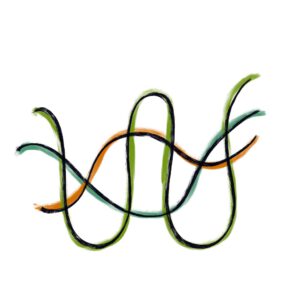 synchronize, stimulate vibrancy)
synchronize, stimulate vibrancy)
The last muscle is the most tricky and encompassing one. Grove is a mysterious thing and hard to pin down (can you imagine a bunch of algorithms getting in a grove?). The first ingredient to groove is alignment; the second one is swing or vibrancy.
Vibrant alignment does not mean we all swim in the same direction. It is also not simply about having a common purpose – it is about that common purpose being in synch with each individual’s purpose. What exactly is the difference? Some collectives breathe an air of leveling: we all do, believe, follow one direction. There are no individual agendas, as the individuals project their entire purpose into the collective. In contrast, self organisation needs the individual agendas charged up and dynamically aligned with the common purpose (Spotify has famously coined this state “Aligned Autonomy”)[8]. It is the slight divergence between the individual and the collective agenda and the tensions arising from it that are the motor for development. If they are not surfaced and not celebrated, the system is aligned but not vibrant.
Training to feed the groove is as challenging as learning to be a good jazz musician. It requires a fine ear and an open mind as well as fluency in our roles. In a sense it builds on all the other muscles: trusting, showing up, self-navigation and so forth. And like all the other muscles, it grows with practical experience.
The list shows a common feature: There are things we are capable of but in our everyday social environments are not practicing, so the corresponding muscles atrophy. Once we re-discover these muscles, we can continue training to reclaim them. Each of the muscles has an individual and a collective quality. I need to get comfortable with showing up and acting on an impulse and we as a team need to find a ways of making the best of that impulse. I need to build practices of self-navigation, we as a team need to establish spaces that support these practices. Both, the individual and the collective quality can be kickstarted by a training session that triggers the corresponding muscle. SOCIUS is working on the first batch of these sessions, so stay tuned and see you in the gym!
[1] Malcom Gladwell (2009): Outliers
[2] Frederic Laloux (2014): Reinventing Organisations: https://www.reinventingorganizations.com
[3] https://www.democracyfitness.eu
[4] Thank you to Aaron Dignan for this term!
[5] Derek Sivers: https://www.youtube.com/watch?v=fW8amMCVAJQ, retrieved, 21.9.22
[6] Bettina Rollow and Joana Breidenbach, 2020: “New Work needs Inner Work”
[7] For some deeper introduction see – https://www.holacracy.org
[8] See Henrik Knibergs famous video on aligened autonomy: https://www.youtube.com/watch?v=_qIh2sYXcQc

